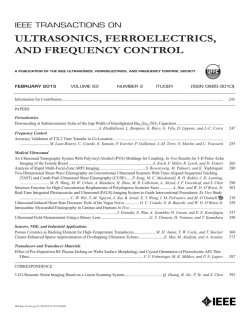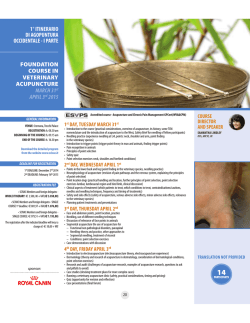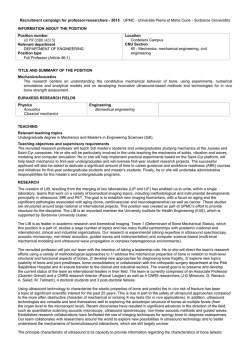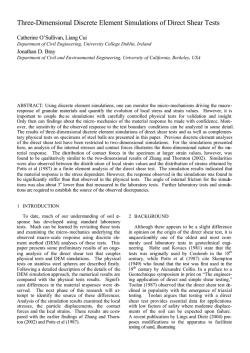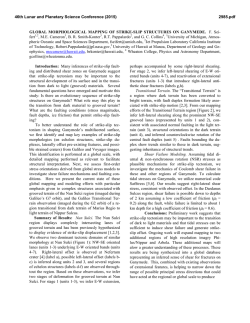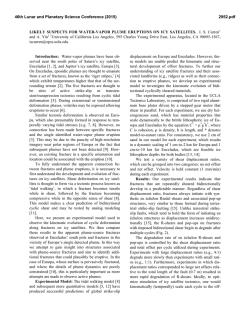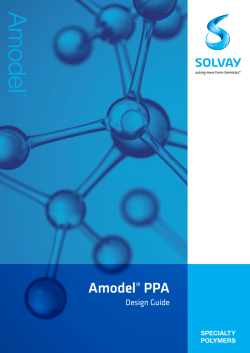
PDF (378 kB) - Archives of Physical Medicine and Rehabilitation
Archives of Physical Medicine and Rehabilitation journal homepage: www.archives-pmr.org Archives of Physical Medicine and Rehabilitation 2013;94:2146-50 ORIGINAL ARTICLE Quantification of Dry Needling and Posture Effects on Myofascial Trigger Points Using Ultrasound Shear-Wave Elastography Ruth M. Maher, PT, PhD, DPT, WCS, BCB-PMD, CEAS,a,b Dawn M. Hayes, PT, PhD, GCS,a Minoru Shinohara, PhD, FACSMc From the aDepartment of Physical Therapy, University of North Georgia, Dahlonega, GA; bUniversity College Dublin, School of Public Health, Physiotherapy and Population Science, Dublin, Ireland; and cSchool of Applied Physiology, Georgia Institute of Technology, Atlanta, GA. Current affiliation for Maher, Division of Physical Therapy, Shenandoah University, Winchester, VA. Abstract Objectives: To determine (1) whether the shear modulus in upper trapezius muscle myofascial trigger points (MTrPs) reduces acutely after dry needling (DN), and (2) whether a change in posture from sitting to prone affects the shear modulus. Design: Ultrasound images were acquired in B mode with a linear transducer oriented in the transverse plane, followed by performance of shearwave elastography (SWE) before and after DN and while sitting and prone. Setting: University. Participants: Women (NZ7; mean age Æ SD, 46Æ17y) with palpable MTrPs were recruited. Intervention: All participants were dry needled in the prone position using solid filament needles that were inserted and manipulated inside the MTrPs. SWE was performed before and after DN in the sitting and prone positions. Main Outcome Measure: MTrPs were evaluated by shear modulus using SWE. Results: Palpable reductions in stiffness were noted after DN and in the prone position. These changes were apparent in the shear modulus map obtained with ultrasound SWE. With significant main effects, the shear modulus reduced from before to after DN (P<.01) and from the sitting to the prone position (P<.05). No significant interaction effect between time and posture was observed. Conclusions: The shear modulus measured with ultrasound SWE reduced after DN and in the prone position compared with sitting, in agreement with reductions in palpable stiffness. These findings suggest that DN and posture have significant effects on the shear modulus of MTrPs, and that shear modulus measurement with ultrasound SWE may be sensitive enough to detect these effects. Archives of Physical Medicine and Rehabilitation 2013;94:2146-50 ª 2013 by the American Congress of Rehabilitation Medicine From 1996 to 2006, U.S. residents more than tripled their spending on prescription analgesics, from $4.2 to $13.2 billion.1 Since myofascial pain has a lifetime prevalence of 85% many chronic pain disorders and syndromes of the musculoskeletal system can be explained by the presence of localized, hyperirritable nodules in taut bands of skeletal muscle called myofascial trigger points (MTrPs).2 These trigger points are tender on palpation and cause pain, restricted range of motion, and substantial motor dysfunction. The etiology of MTrPs is suggested to be due to motor endplate dysfunction.2,3 No commercial party having a direct financial interest in the results of the research supporting this article has conferred or will confer a benefit on the authors or on any organization with which the authors are associated. Dry needling is a technique used by a variety of clinicians in the treatment of myofascial pain and motor dysfunction. A fine-gauge, solid filament needle is inserted into discrete focal points of taut bands within muscle and manipulated until local twitch responses (LTRs) are elicited. The LTR is an involuntary spinal reflex contraction of muscle fibers within a taut band and occurs during needling of a taut band. This LTR elicited by dry needling is associated with pain relief and a palpable reduction of muscle stiffness.4 Despite the clinical efficacy of dry needling for alleviating the symptoms of MTrPs, objective quantification of the severity of MTrPs in terms of muscle stiffness has not been possible. The literature has shown that 2- and 3-dimensional ultrasound imaging can be used for visualizing MTrPs and their associated 0003-9993/13/$36 - see front matter ª 2013 by the American Congress of Rehabilitation Medicine http://dx.doi.org/10.1016/j.apmr.2013.04.021 Quantification of stiffness in myofascial trigger points characteristics.5-10 Recently developed ultrasound shear-wave imaging technology measures the shear-wave propagation through soft tissues, thereby allowing for the objective quantification of the soft tissue stiffness in real time by means of the shear modulus (in kilopascals). It would be useful if this technology could provide a means for quantifying the muscle stiffness associated with MTrPs. Although this technology has been applied to healthy human skeletal muscles,11,12 the applicability of the technology to MTrPs and its treatment with dry needling is unknown. Hence, we performed a preliminary study to provide insights into the applicability of the ultrasound shear-wave imaging technology in assessing the efficacy of dry needling on muscle stiffness that is associated with MTrPs. We expected that the shear modulus in the trapezius muscle would be reduced acutely as a result of dry needling. In clinical practice, the upper trapezius muscle is palpated with the patient in the sitting, supine, or prone position. Since neuromuscular excitability is reduced in the supine position compared with the sitting position,13 we also expected that the shear modulus in the trapezius muscle would be reduced with a change in posture from the sitting to the prone position. The primary and secondary objectives of this preliminary study were as follows: (1) to compare the shear modulus of the upper trapezius muscle with MTrPs before and after dry needling, and (2) to compare the shear modulus of the upper trapezius muscle between the prone and sitting positions, using ultrasound shearwave elastography. Methods Study population Seven women (mean age Æ SD, 46Æ17.3y) who had palpable MTrPs in their upper trapezius muscle were recruited. Subjects completed a prescreening health history questionnaire and were required to present with a palpable taut band that elicited pain and the jump sign on palpation in the upper trapezius. Exclusion criteria included a history of cervical radiculopathy, myelopathy, muscular pain caused by fibromyalgia, trigger point injections in the past 6 months, medications that affect muscle function, or surgery to the neck or shoulder. Palpation was in the central region of the upper trapezius muscle within 6cm of the muscular midline (approximately midway between the cervical vertebrae and the acromion process).8 In those who had bilateral trigger points, the one that exhibited the most acute pain and jump sign was chosen as the experimental site. The location of the trigger point was marked on the skin. The University of North Georgia Institutional Review Board approved this study, and each subject provided written informed consent to participate. Ultrasound imaging with shear-wave elastography Ultrasound images were acquired in B mode using an ultrasound system (Aixplorer version 4.0a) with a 4- to 15-MHz linear array transducer.a The transducer was oriented in the transverse plane List of abbreviations: ANOVA analysis of variance LTR local twitch response MTrPs myofascial trigger points www.archives-pmr.org 2147 over the region of interest on the upper trapezius muscle, and the transducer was manipulated until the muscle fibers appeared parallel. The boundaries of the transducer were then marked on the skin to standardize the transducer position. Once a clear image was acquired in B mode, supersonic shear imaging mode was used to obtain the shear modulus map of the muscle for the region of interest. Three elastography images were acquired in 5 seconds before and immediately after dry needling in 2 subject postures: (1) while subjects sat upright in a high backed chair, shoulders relaxed with arms supported by armrests; and (2) in the prone position with arms resting alongside their trunk. From each elastography image, the spatial average of the shear modulus (kPa) in an 8-mm circular area was determined, and the values were averaged across 3 measurements in each condition. Dry needling All subjects were dry needled in the prone position using a slowvelocity technique. A solid filament needle with guide tubeb (0.2Â50mm) was inserted into the trigger point in the upper trapezius muscle. The needle was manipulated up and down (sweeps) inside the trigger point 10 times in an effort to standardize the dry needling protocol. Several LTRs were elicited. Statistical analysis The dependent variable was the shear modulus of the upper trapezius muscle. The effects of time (before and after dry needling) and posture (sitting and prone) were analyzed using a 2-way repeated analysis of variance (ANOVA). An alpha value less than .05 was considered significant. Mean data are presented. Results Palpable reductions in stiffness were noted after dry needling and in the prone position. The reduction in stiffness resulting from dry needling and the difference between postures were apparent in the shear modulus map obtained with ultrasound elastography (fig 1). When data in individual subjects were examined (table 1), reductions in the shear modulus resulting from dry needling were observed in all 7 subjects in both the sitting and prone positions. By changing the posture from the sitting to prone position, the shear modulus decreased in 5 of 7 subjects both before and after dry needling. The amount of decrease resulting from the posture change ranged from .29 to 9.82kPa, whereas the amount of increase ranged from .16-1.35kPa. ANOVA found significant main effects of time (P<.01) and posture (P<.05) on the shear modulus (fig 2). The effect of time demonstrated a 29.5% reduction in the shear modulus after dry needling, and the effect of posture demonstrated a 21% reduction in the shear modulus from the sitting to the prone position, on average (fig 3). A significant interaction effect between time and posture was not observed. Discussion The new findings of the preliminary study are that the shear modulus of the upper trapezius muscle with MTrPs was significantly reduced after dry needling and in the prone position, in agreement with reductions in palpable stiffness. These findings support that shear-wave elastography could quantitatively detect 2148 R.M. Maher et al Fig 1 An example of a change in shear modulus in the upper trapezius muscle resulting from dry needling and posture. Color-coded representation in the presence of a palpable MTrP in the upper trapezius muscle in the sitting position before (A) and after dry needling (B) and in the prone position before (C) and after dry needling (D). The color-coded scale was identical across images. changes in stiffness in the form of shear modulus before and after dry needling in the upper trapezius with MTrPs and with a change in position from sitting to prone. These preliminary findings provide a proof of concept for supporting that the technology would be beneficial in that it can assess the morphology associated with MTrPs, validate palpation as a means of diagnosing MTrPs, and more importantly assess the effects of interventions such as dry needling on these trigger points. There is general agreement that any kind of muscle overuse or direct trauma to the muscle can lead to the development of MTrPs; however, the etiology and pathophysiology associated with MTrPs are currently being studied but remain unclear.14 The proposed etiology regarding MTrPs is that motor endplates of neurons terminating at the muscle fibers of MTrPs have abnormal activity, and that sustained sarcomere contracture leads to increased local metabolic demand, compressed capillary circulation, and increased metabolic by-products.2,3,15-22 In recent studies21,22 that assessed the “biochemical milieu” or biochemical composition associated with trigger points in the upper trapezius, elevated levels of histochemicals, such as inflammatory mediators, proinflammatory cytokines, catecholamines, and neuropeptides, and more acidic pH levels associated with chronic pain and inflammation were found in active MTrPs compared with normal muscle tissue. Eliciting the LTR with dry needling reduced the presence of these substances within the MTrPs, and the reductions were associated with a decrease in pain and palpable stiffness.21 The Fig 2 Effect of dry needling and posture on shear modulus of the upper trapezius muscle. Main effects of dry needling (time) and posture (position) are presented. **P<.01 vs Pre; *P<.05 vs Sitting. LTR is an involuntary spinal reflex that results from mechanical stimulation of the MTrP. It is visible and palpable, and thought to occur in response to altered sensory spinal processing resulting from sensitized peripheral mechanical nociceptors.4,10 This event is associated with pain relief and a reduction of stiffness that is palpable and observable on ultrasound imaging.21 The LTR is therefore considered an objective sign of the presence of an MTrP. Hence, the presence of MTrPs and the reduction in palpable stiffness after dry needling are supported by the literature. The novelty and significance of the present study is the objective quantification of the stiffness reduction using ultrasound shear-wave elastography. Palpation, pressure algometry, and subjective pain reports are commonly used to diagnose and assess outcomes associated with MTrPs. However, only moderate evidence for the reproducibility of trigger point palpation of the trapezius for local tenderness exists.23 The absence of objective and reliable visual inspection of MTrPs has affected the willingness of the medical community to accept their existence and affected the ability of clinicians to accurately assess treatment outcomes.14 Several handheld devices have described viscoelasticity based on tissue indentation induced by manual compression and static elastography using ultrasound imaging. However, accurate quantification of stiffness cannot be made using these Table 1 Shear modulus (kPa) of individual subjects for each testing condition: time (before and after dry needling) and position (sitting and prone) Sitting Prone Subject Before After Before After 1 2 3 4 5 6 7 Mean 11.29 9.62 15.72 12.28 10.66 18.46 16.89 13.56 8.87 9.60 12.32 8.83 8.81 9.16 6.18 9.11 7.94 10.94 11.82 9.89 12.01 11.96 7.07 10.23 5.91 7.44 6.74 8.51 8.52 10.2 6.34 7.67 Fig 3 Relative changes in shear modulus of the upper trapezius muscle resulting from dry needling and subject posture. (Left) Relative change from before to after dry needling. (Right) Relative change from sitting to prone position. www.archives-pmr.org Quantification of stiffness in myofascial trigger points devices because of the variability in stress dissipation by other tissues (ie, skin, fat, fascia) and variable compression by the user, which could artificially increase the tissue stiffness.12 In contrast, supersonic shear imaging with shear-wave elastography requires no manual compression because the deformation of tissue leading to shear waves is created by an acoustic impulse that is generated electronically and delivered through the ultrasound transducer.24 The recent observation of faster shear-wave propagation velocity within the region of active MTrPs compared with the surrounding region in the upper trapezius muscle, albeit using an external vibrator, is in line with the idea that MTrPs are associated with higher shear modulus.8 With the use of the current ultrasound shear-wave elastography, tissue stiffness can be visualized in real time, while the effects of dry needling are readily observed and displayed via a color-coded map. The significant reduction in shear modulus in the current study supports that shear modulus measurements with this technology may be sensitive enough to identify the reductions in tissue stiffness after dry needling. Our findings show that tissue stiffness can be visualized in real time, while the effects of dry needling are readily observed and displayed via a color-coded map. The significant reduction objectively quantified an immediate reduction in shear modulus when going from a sitting to a prone position in all subjects who had MTrPs in the upper trapezius before and after dry needling. The relationship between sitting posture and neck pain has been discussed in the literature,25,26 but the etiology is poorly defined.27 Few studies have examined the role muscles play in supporting the body under gravitational forces. However, one study13 noted an immediate decrease in the tone and stiffness of the upper trapezius, which occurred with a change from a sitting to a supine position in healthy subjects, by using a handheld device to assess indentation. These findings may lead to a better understanding of how static postures can contribute to neck pain and the development of MTrPs, especially in those who work with visual display terminals. The muscle assessed in this study was a superficial muscle that is easy to palpate. The same cannot be said for deeper muscles such as those in the lumbar region or deep abdominal area. Consequently, an inability to palpate and reproduce the classic referral patterns is difficult to accomplish for the clinician. Shearwave elastography would provide such a means for an objective evaluation of tissues of different types and depths, and a means to determine the efficacy and longevity of therapeutic interventions. Study limitations The findings of this preliminary study cannot be generalized because of the small sample size. Conclusions The preliminary results with a limited study population showed that the shear modulus of the upper trapezius muscle with MTrPs, measured with ultrasound shear-wave elastography, was significantly reduced after dry needling and in the prone position compared with the sitting position, in agreement with reductions in palpable stiffness. These preliminary findings suggest that dry needling and the subject’s posture may affect the shear modulus of MTrPs, and that shear modulus measurement with ultrasound shear-wave elastography may be sensitive enough to detect these effects. www.archives-pmr.org 2149 Suppliers a. SuperSonic Imagine, 11714 North Creek Pkwy N, Ste 150, Bothell, WA 98011. b. HBW Supply Inc, 1090 Investor Pl, San Jacinto Hemet, CA 92583. Keywords Elasticity imaging techniques; Trigger points; Rehabilitation; Ultrasonography Corresponding author Ruth M. Maher, PT, PhD, DPT, WCS, BCB-PMD, CEAS, Shenandoah University, Division of Physical Therapy, 333 W Cork St, Suite 40, Winchester, VA 22601. E-mail address: [email protected]. Acknowledgments We thank Supersonic Imagine, USA, for lending the ultrasound device for the duration of this study. References 1. Stagnitti MN. Trends in outpatient prescription analgesics utilization and expenditures for the U.S. civilian noninstitutionalized population, 1996 and 2006. Statistical brief no. 235. Rockville: Agency for Healthcare Research and Quality; 2009. Available at: http://www.meps.ahrq.gov/mepsweb/ data_files/publications/st235/stat235.pdf. Accessed January 4, 2013. 2. Simons DG. Clinical and etiological update of myofascial pain from trigger points. J Musculoskel Pain 1996;4:93-122. 3. Hubbard DR, Berkoff GM. Myofascial trigger points show spontaneous needle EMG activity. Spine 1993;18:1803-7. 4. Hsieh YL, Kao MJ, Kuan TS, Chen SM, Chen JT, Hong CZ. Dry needling to a key myofascial trigger point may reduce the irritability of satellite myofascial trigger points. Am J Phys Med Rehabil 2007;86:397-403. 5. Bubnov RV. The use of trigger point “dry” needling under ultrasound guidance for the treatment of myofascial pain (technological innovation and literature review). Lik Sprava 2010;(5-6):56-64. 6. Shankar H, Reddy S. Two- and three-dimensional ultrasound imaging to facilitate detection and targeting of taut bands in myofascial pain syndrome. Pain Med 2012;13:971-5. 7. Ballyns JJ, Shah JP, Hammond J, Gebreat T, Gerber LH, Sikdar S. Objective sonographic measures for characterizing myofascial trigger points associated with cervical pain. J Ultrasound Med 2011;30: 1331-40. 8. Ballyns JJ, Turo D, Otto P, et al. Office-based elastographic technique for quantifying mechanical properties of skeletal muscle. J Ultrasound Med 2012;31:1209-19. 9. Sikdar S, Shah JP, Gebreab T, et al. Novel applications of ultrasound technology to visualize and characterize myofascial trigger points and surrounding soft tissue. Arch Phys Med Rehabil 2009;90:1829-38. 10. Rha DW, Shin JC, Kim YK, Jung JH, Kim YU, Lee SC. Detecting local twitch responses of myofascial trigger points in the lower-back muscles using ultrasonography. Arch Phys Med Rehabil 2011;92:1576-80. 11. Botanlioglu H, Kantarci F, Kaynak G, et al. Shear wave elastography properties of vastus lateralis and vastus medialis obliquus muscles in normal subjects and female patients with patellofemoral pain syndrome. Skeletal Radiol 2013;42:659-66. 12. Shinohara M, Sabra K, Gennisson JL, Fink M, Tanter M. Real-time visualization of muscle stiffness distribution with ultrasound shear 2150 13. 14. 15. 16. 17. 18. 19. 20. wave imaging during muscle contraction. Muscle Nerve 2010;42: 438-41. Viir R, Virkus A, Laiho K, Rajaleid K, Selart A, Mikkelsson M. Trapezius muscle tone and viscoelastic properties in sitting and supine positions. Scand J Work Environ Health 2007;3(Suppl):76-80. Vulfsons S, Ratmansky M, Kalichman L. Trigger point needling: techniques and outcome. Curr Pain Headache Rep 2012;16:407-12. Simons D. Do endplate noise and spikes arise from normal motor endplates? Am J Phys Med Rehabil 2001;80:134-40. Hong CZ. Lidocaine injection versus dry needling to myofascial trigger point. The importance of the local twitch response. Am J Phys Med Rehabil 1994;73:256-63. Hong CZ, Torigoe Y. Electrophysiological characteristics of localized twitch responses in responsive taut bands of rabbit skeletal muscle fibers are related to the reflexes at a spinal cord level. J Musculoskel Pain 1994;2:17-43. Huguenin LK. Myofascial trigger points: the current evidence. Phys Ther Sport 2004;5:2-12. Dommerholt J, Bron C, Franssen J. Myofascial trigger points: an evidence-informed review. J Man Manip Ther 2006;14:203-21. Dommerholt J, Mayoral del Moral O, Gro¨bli C. Trigger point dry needling. J Man Manip Ther 2006;14:E70-87. R.M. Maher et al 21. Shah JP, Danoff JV, Desai MJ, et al. Biochemicals associated with pain and inflammation are elevated in sites near to and remote from active myofascial trigger points. Arch Phys Med Rehabil 2008;89:16-23. 22. Shah K, Gillians E. Uncovering the biochemical milieu of myofascial trigger points using in vivo microdialysis: an application of muscle pain concepts to myofascial pain syndrome. J Bodyw Mov Ther 2005; 12:371-84. 23. Myburgh C, Larsen AH, Hartvigsen J. A systematic, critical review of manual palpation for identifying myofascial trigger points: evidence and clinical significance. Arch Phys Med Rehabil 2008;89:1169-76. 24. Cosgrove DO, Berg WA, Dore´ CJ, et al. Shear wave elastography for breast masses is highly reproducible. Eur Radiol 2012;22:1023-32. 25. Skov T, Borg V, Orhede E. Psychosocial and physical risk factors for musculoskeletal disorders of the neck, shoulders, and lower back in sales people. Occup Environ Med 1996;53:351-6. 26. Cagnie B, Danneels L, Van Tiggelen D, De Loose V, Cambier D. Individual and work related risk factors for neck pain among office workers: a cross sectional study. Eur Spine J 2007;16:679-86. 27. Ranasinghe P, Perera YS, Lamabadusuriya DA, et al. Work related complaints of neck, shoulder and arm among computer office workers: a cross-sectional evaluation of prevalence and risk factors in a developing country. Environ Health 2011;10:70. www.archives-pmr.org
© Copyright 2025
